The second law of thermodynamics

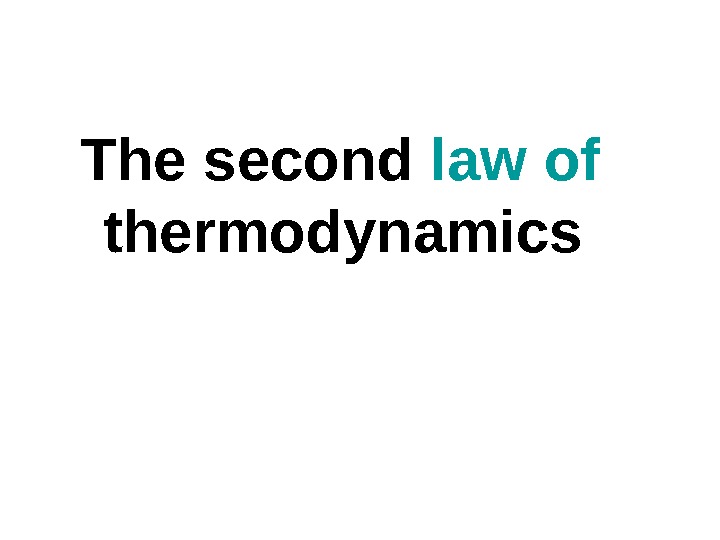
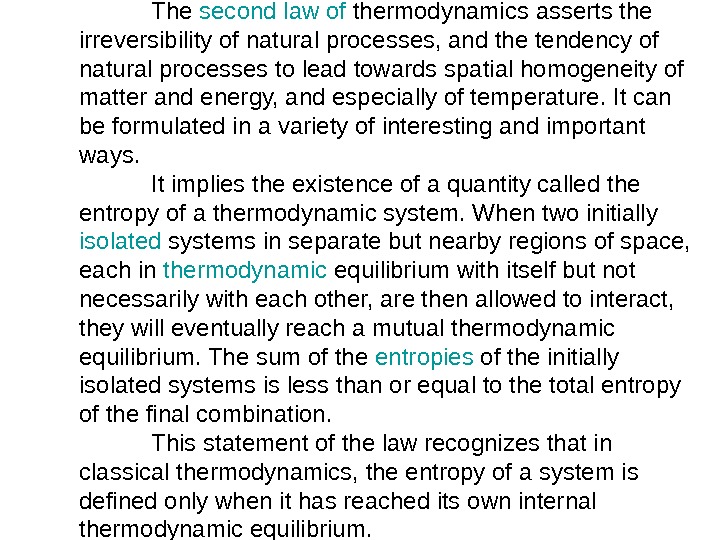
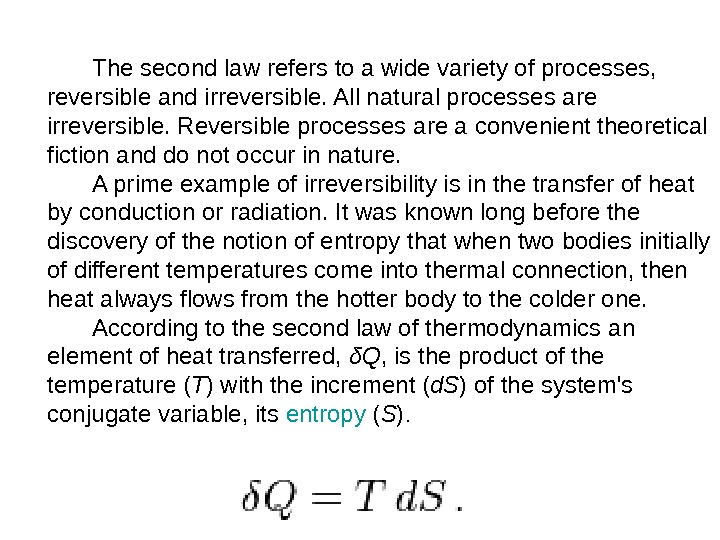
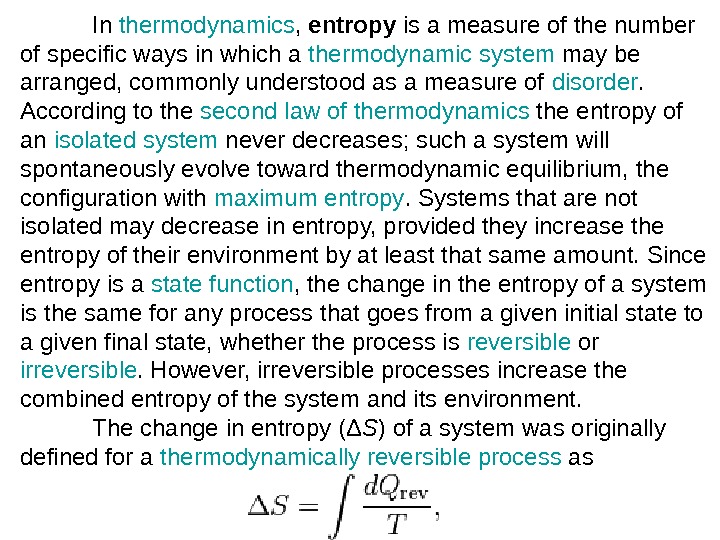
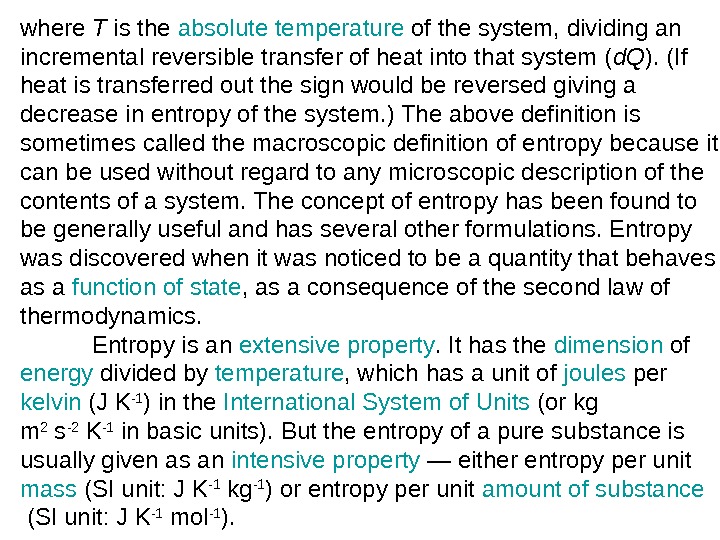
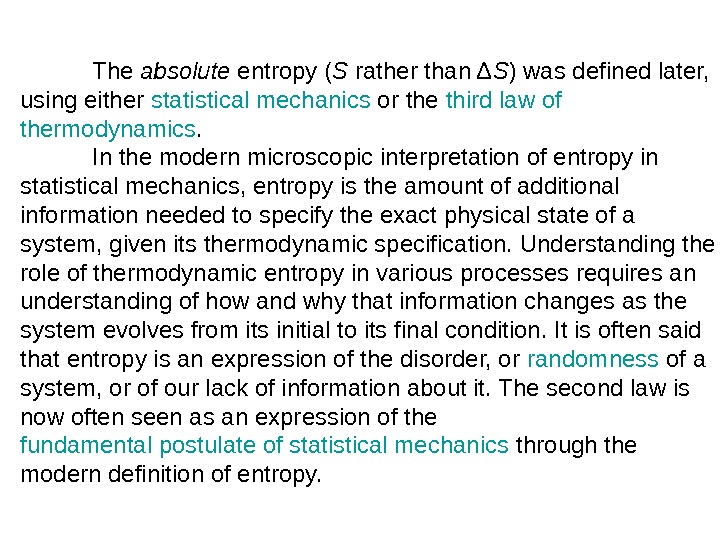
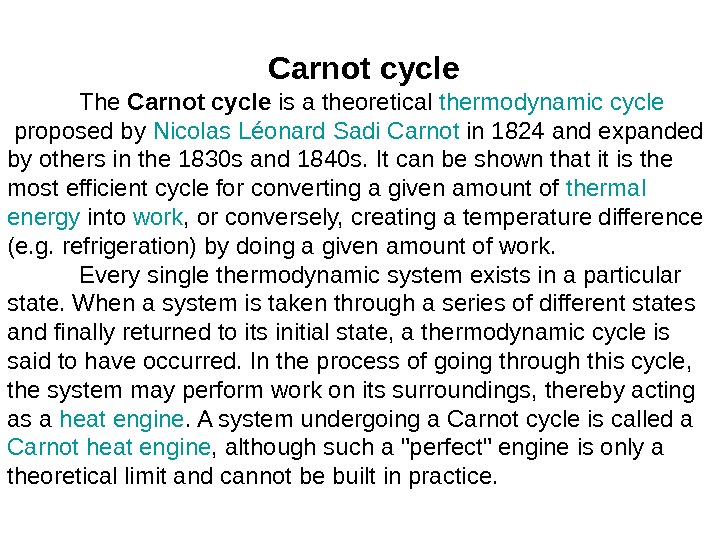
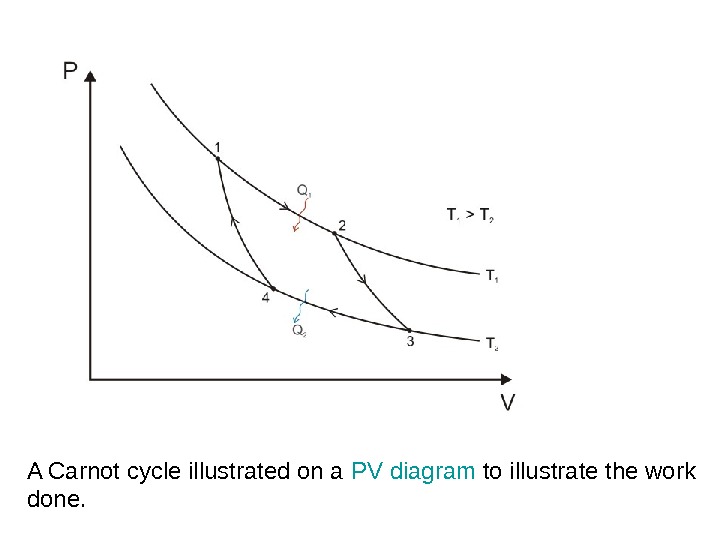

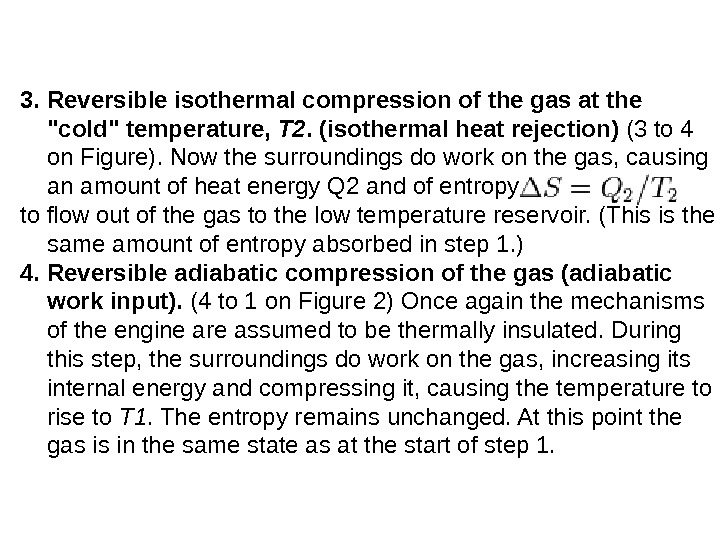

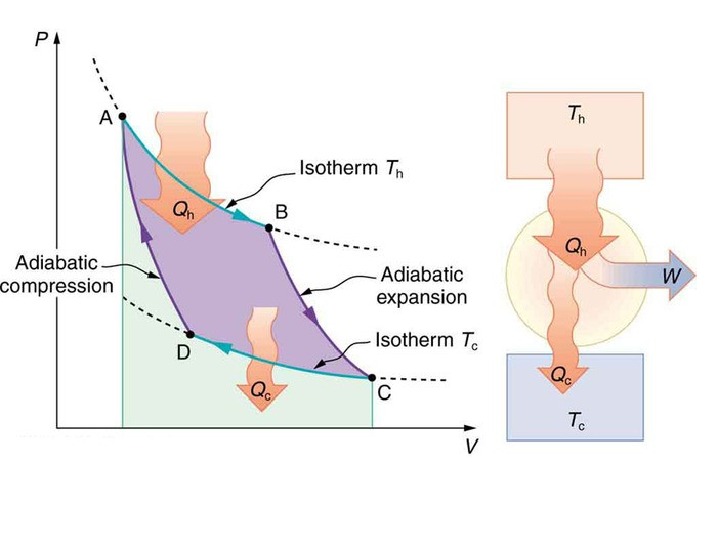

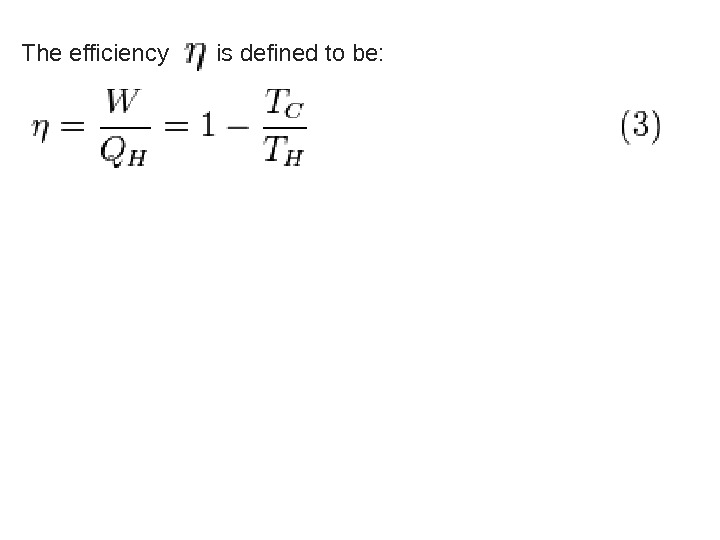
- Размер: 224 Кб
- Количество слайдов: 14
Описание презентации The second law of thermodynamics по слайдам
 The second law of thermodynamics
The second law of thermodynamics
 The second law of thermodynamics asserts the irreversibility of natural processes, and the tendency of natural processes to lead towards spatial homogeneity of matter and energy, and especially of temperature. It can be formulated in a variety of interesting and important ways. It implies the existence of a quantity called the entropy of a thermodynamic system. When two initially isolated systems in separate but nearby regions of space, each in thermodynamic equilibrium with itself but not necessarily with each other, are then allowed to interact, they will eventually reach a mutual thermodynamic equilibrium. The sum of the entropies of the initially isolated systems is less than or equal to the total entropy of the final combination. This statement of the law recognizes that in classical thermodynamics, the entropy of a system is defined only when it has reached its own internal thermodynamic equilibrium.
The second law of thermodynamics asserts the irreversibility of natural processes, and the tendency of natural processes to lead towards spatial homogeneity of matter and energy, and especially of temperature. It can be formulated in a variety of interesting and important ways. It implies the existence of a quantity called the entropy of a thermodynamic system. When two initially isolated systems in separate but nearby regions of space, each in thermodynamic equilibrium with itself but not necessarily with each other, are then allowed to interact, they will eventually reach a mutual thermodynamic equilibrium. The sum of the entropies of the initially isolated systems is less than or equal to the total entropy of the final combination. This statement of the law recognizes that in classical thermodynamics, the entropy of a system is defined only when it has reached its own internal thermodynamic equilibrium.
 The second law refers to a wide variety of processes, reversible and irreversible. All natural processes are irreversible. Reversible processes are a convenient theoretical fiction and do not occur in nature. A prime example of irreversibility is in the transfer of heat by conduction or radiation. It was known long before the discovery of the notion of entropy that when two bodies initially of different temperatures come into thermal connection, then heat always flows from the hotter body to the colder one. According to the second law of thermodynamics an element of heat transferred, δQ , is the product of the temperature ( T ) with the increment ( d. S ) of the system’s conjugate variable, its entropy ( S ).
The second law refers to a wide variety of processes, reversible and irreversible. All natural processes are irreversible. Reversible processes are a convenient theoretical fiction and do not occur in nature. A prime example of irreversibility is in the transfer of heat by conduction or radiation. It was known long before the discovery of the notion of entropy that when two bodies initially of different temperatures come into thermal connection, then heat always flows from the hotter body to the colder one. According to the second law of thermodynamics an element of heat transferred, δQ , is the product of the temperature ( T ) with the increment ( d. S ) of the system’s conjugate variable, its entropy ( S ).
 In thermodynamics , entropy is a measure of the number of specific ways in which a thermodynamic system may be arranged, commonly understood as a measure of disorder. According to the second law of thermodynamics the entropy of an isolated system never decreases; such a system will spontaneously evolve toward thermodynamic equilibrium, the configuration with maximum entropy. Systems that are not isolated may decrease in entropy, provided they increase the entropy of their environment by at least that same amount. Since entropy is a state function , the change in the entropy of a system is the same for any process that goes from a given initial state to a given final state, whether the process is reversible or irreversible. However, irreversible processes increase the combined entropy of the system and its environment. The change in entropy (Δ S ) of a system was originally defined for a thermodynamically reversible process as
In thermodynamics , entropy is a measure of the number of specific ways in which a thermodynamic system may be arranged, commonly understood as a measure of disorder. According to the second law of thermodynamics the entropy of an isolated system never decreases; such a system will spontaneously evolve toward thermodynamic equilibrium, the configuration with maximum entropy. Systems that are not isolated may decrease in entropy, provided they increase the entropy of their environment by at least that same amount. Since entropy is a state function , the change in the entropy of a system is the same for any process that goes from a given initial state to a given final state, whether the process is reversible or irreversible. However, irreversible processes increase the combined entropy of the system and its environment. The change in entropy (Δ S ) of a system was originally defined for a thermodynamically reversible process as
 where T is the absolute temperature of the system, dividing an incremental reversible transfer of heat into that system ( d. Q ). (If heat is transferred out the sign would be reversed giving a decrease in entropy of the system. ) The above definition is sometimes called the macroscopic definition of entropy because it can be used without regard to any microscopic description of the contents of a system. The concept of entropy has been found to be generally useful and has several other formulations. Entropy was discovered when it was noticed to be a quantity that behaves as a function of state , as a consequence of the second law of thermodynamics. Entropy is an extensive property. It has the dimension of energy divided by temperature , which has a unit of joules per kelvin (J K -1 ) in the International System of Units (or kg m 2 s — 2 K -1 in basic units). But the entropy of a pure substance is usually given as an intensive property — either entropy per unit mass (SI unit: J K -1 kg -1 ) or entropy per unit amount of substance (SI unit: J K -1 mol -1 ).
where T is the absolute temperature of the system, dividing an incremental reversible transfer of heat into that system ( d. Q ). (If heat is transferred out the sign would be reversed giving a decrease in entropy of the system. ) The above definition is sometimes called the macroscopic definition of entropy because it can be used without regard to any microscopic description of the contents of a system. The concept of entropy has been found to be generally useful and has several other formulations. Entropy was discovered when it was noticed to be a quantity that behaves as a function of state , as a consequence of the second law of thermodynamics. Entropy is an extensive property. It has the dimension of energy divided by temperature , which has a unit of joules per kelvin (J K -1 ) in the International System of Units (or kg m 2 s — 2 K -1 in basic units). But the entropy of a pure substance is usually given as an intensive property — either entropy per unit mass (SI unit: J K -1 kg -1 ) or entropy per unit amount of substance (SI unit: J K -1 mol -1 ).
 The absolute entropy ( S rather than Δ S ) was defined later, using either statistical mechanics or the third law of thermodynamics. In the modern microscopic interpretation of entropy in statistical mechanics, entropy is the amount of additional information needed to specify the exact physical state of a system, given its thermodynamic specification. Understanding the role of thermodynamic entropy in various processes requires an understanding of how and why that information changes as the system evolves from its initial to its final condition. It is often said that entropy is an expression of the disorder, or randomness of a system, or of our lack of information about it. The second law is now often seen as an expression of the fundamental postulate of statistical mechanics through the modern definition of entropy.
The absolute entropy ( S rather than Δ S ) was defined later, using either statistical mechanics or the third law of thermodynamics. In the modern microscopic interpretation of entropy in statistical mechanics, entropy is the amount of additional information needed to specify the exact physical state of a system, given its thermodynamic specification. Understanding the role of thermodynamic entropy in various processes requires an understanding of how and why that information changes as the system evolves from its initial to its final condition. It is often said that entropy is an expression of the disorder, or randomness of a system, or of our lack of information about it. The second law is now often seen as an expression of the fundamental postulate of statistical mechanics through the modern definition of entropy.
 Carnotcycle The Carnotcycle is a theoretical thermodynamic cycle proposed by Nicolas Léonard Sadi Carnot in 1824 and expanded by others in the 1830 s and 1840 s. It can be shown that it is the most efficient cycle for converting a given amount of thermal energy into work , or conversely, creating a temperature difference (e. g. refrigeration) by doing a given amount of work. Every single thermodynamic system exists in a particular state. When a system is taken through a series of different states and finally returned to its initial state, a thermodynamic cycle is said to have occurred. In the process of going through this cycle, the system may perform work on its surroundings, thereby acting as a heat engine. A system undergoing a Carnot cycle is called a Carnot heat engine , although such a «perfect» engine is only a theoretical limit and cannot be built in practice.
Carnotcycle The Carnotcycle is a theoretical thermodynamic cycle proposed by Nicolas Léonard Sadi Carnot in 1824 and expanded by others in the 1830 s and 1840 s. It can be shown that it is the most efficient cycle for converting a given amount of thermal energy into work , or conversely, creating a temperature difference (e. g. refrigeration) by doing a given amount of work. Every single thermodynamic system exists in a particular state. When a system is taken through a series of different states and finally returned to its initial state, a thermodynamic cycle is said to have occurred. In the process of going through this cycle, the system may perform work on its surroundings, thereby acting as a heat engine. A system undergoing a Carnot cycle is called a Carnot heat engine , although such a «perfect» engine is only a theoretical limit and cannot be built in practice.
 A Carnot cycle illustrated on a PV diagram to illustrate the work done.
A Carnot cycle illustrated on a PV diagram to illustrate the work done.
 The Carnot cycle when acting as a heat engine consists of the following steps: 1. Reversible isothermal expansionofthegasatthe»hot» temperature, T 1 (isothermalheatadditionor absorption). During this step (1 to 2 on Figure) the gas is allowed to expand it does work on the surroundings. The temperature of the gas does not change during the process, and thus the expansion is isothermal. The gas expansion is propelled by absorption of heat energy Q 1 and of entropy from the high temperature reservoir. 1. R eversibleadiabaticexpansionofthegas(adiabatic work output). For this step (2 to 3 on Figure) the mechanisms of the engine are assumed to be thermally insulated, thus they neither gain nor lose heat. The gas continues to expand, doing work on the surroundings, and losing an equivalent amount of internal energy. The gas expansion causes it to cool to the «cold» temperature, T 2. The entropy remains unchanged.
The Carnot cycle when acting as a heat engine consists of the following steps: 1. Reversible isothermal expansionofthegasatthe»hot» temperature, T 1 (isothermalheatadditionor absorption). During this step (1 to 2 on Figure) the gas is allowed to expand it does work on the surroundings. The temperature of the gas does not change during the process, and thus the expansion is isothermal. The gas expansion is propelled by absorption of heat energy Q 1 and of entropy from the high temperature reservoir. 1. R eversibleadiabaticexpansionofthegas(adiabatic work output). For this step (2 to 3 on Figure) the mechanisms of the engine are assumed to be thermally insulated, thus they neither gain nor lose heat. The gas continues to expand, doing work on the surroundings, and losing an equivalent amount of internal energy. The gas expansion causes it to cool to the «cold» temperature, T 2. The entropy remains unchanged.
 3. Reversibleisothermalcompressionofthegasatthe «cold»temperature, T 2. (isothermalheatrejection) (3 to 4 on Figure). Now the surroundings do work on the gas, causing an amount of heat energy Q 2 and of entropy to flow out of the gas to the low temperature reservoir. (This is the same amount of entropy absorbed in step 1. ) 4. R eversibleadiabatic compressionofthegas(adiabatic workinput). (4 to 1 on Figure 2) Once again the mechanisms of the engine are assumed to be thermally insulated. During this step, the surroundings do work on the gas, increasing its internal energy and compressing it, causing the temperature to rise to T 1. The entropy remains unchanged. At this point the gas is in the same state as at the start of step 1.
3. Reversibleisothermalcompressionofthegasatthe «cold»temperature, T 2. (isothermalheatrejection) (3 to 4 on Figure). Now the surroundings do work on the gas, causing an amount of heat energy Q 2 and of entropy to flow out of the gas to the low temperature reservoir. (This is the same amount of entropy absorbed in step 1. ) 4. R eversibleadiabatic compressionofthegas(adiabatic workinput). (4 to 1 on Figure 2) Once again the mechanisms of the engine are assumed to be thermally insulated. During this step, the surroundings do work on the gas, increasing its internal energy and compressing it, causing the temperature to rise to T 1. The entropy remains unchanged. At this point the gas is in the same state as at the start of step 1.
 The Carnot heat-engine cycle described is a totally reversible cycle. That is, all the processes that comprise it can be reversed, in which case it becomes the Carnot refrigeration cycle. This time, the cycle remains exactly the same except that the directions of any heat and work interactions are reversed. Heat is absorbed from the low-temperature reservoir, heat is rejected to a high-temperature reservoir, and a work input is required to accomplish all this. The P-V diagram of the reversed Carnot cycle is the same as for the Carnot cycle except that the directions of the processes are reversed.
The Carnot heat-engine cycle described is a totally reversible cycle. That is, all the processes that comprise it can be reversed, in which case it becomes the Carnot refrigeration cycle. This time, the cycle remains exactly the same except that the directions of any heat and work interactions are reversed. Heat is absorbed from the low-temperature reservoir, heat is rejected to a high-temperature reservoir, and a work input is required to accomplish all this. The P-V diagram of the reversed Carnot cycle is the same as for the Carnot cycle except that the directions of the processes are reversed.


 The efficiency is defined to be:
The efficiency is defined to be:

